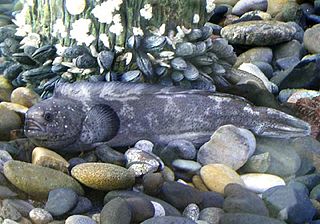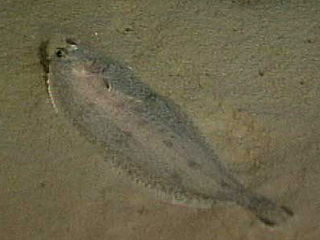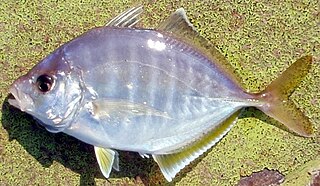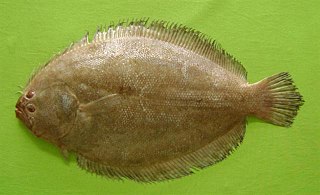
A flatfish is a member of the ray-finned demersal fish order Pleuronectiformes, also called the Heterosomata, sometimes classified as a suborder of Perciformes. In many species, both eyes lie on one side of the head, one or the other migrating through or around the head during development. Some species face their left sides upward, some face their right sides upward, and others face either side upward.

The prowfish is a species of scorpaeniform marine fish found in the northern Pacific Ocean. It is the only extant member of the family, Zaproridae. Another species, Araeosteus rothi, is known from Late Miocene marine strata in Southern California.

White sturgeon is a species of sturgeon in the family Acipenseridae of the order Acipenseriformes. They are an anadromous (migratory) fish species ranging in the Eastern Pacific; from the Gulf of Alaska to Monterey, California. However, some are landlocked in the Columbia River Drainage, Montana, and Lake Shasta in California, with reported sightings in northern Baja California, Mexico.

The Pacific staghorn sculpin is a species of marine ray-finned fish belonging to the family Cottidae, the typical sculpins. This species is found in the eastern Pacific Ocean. It is the only species in the monospecific genus Lepidocottus.

The horn shark is a species of bullhead shark, in the family Heterodontidae. It is endemic to the coastal waters off the western coast of North America, from California to the Gulf of California. Young sharks are segregated spatially from the adults, with the former preferring deeper sandy flats and the latter preferring shallower rocky reefs or algal beds. A small species typically measuring 1 m (3.3 ft) in length, the horn shark can be recognized by a short, blunt head with ridges over its eyes, two high dorsal fins with large spines, and a brown or gray coloration with many small dark spots.

The witch, known in English by a variety of other common names including the witch flounder, pole flounder, craig fluke, Torbay sole, and grey sole, is a species of flatfish from the family Pleuronectidae. It occurs on both sides of the North Atlantic Ocean on muddy sea beds in quite deep water. In northern Europe it has some importance in fisheries as a food fish.

The grey triggerfish, or gray triggerfish, is a species of ray-finned fish in the triggerfish family. The species is native to shallow parts of the western Atlantic from Nova Scotia to Argentina and also the eastern Atlantic, the Mediterranean Sea and off Angola on the west coast of Africa.

The European flounder is a flatfish of European coastal waters from the White Sea in the north to the Mediterranean and the Black Sea in the south. It has been introduced into the United States and Canada accidentally through transport in ballast water. It is caught and used for human consumption.

Caesionidae, the fusiliers, are a family of marine ray-finned fishes in the order Perciformes. The family includes about 23 species. They are related to the snappers, but adapted for feeding on plankton, rather than on larger prey. They are found at reefs in the Indo-Pacific and in the Red Sea.

The whitefin trevally, also known as the horse trevally, is a species of deep water offshore fish in the jack family Carangidae. The species inhabits the tropical to temperate waters of the Indo-Pacific and central Pacific, ranging from South Africa in the west to Hawaii in the east. The whitefin trevally is a moderate-sized fish, growing to 37 cm, and is distinguished by a number of morphological traits, including fin size, gill raker count, and colour. It inhabits the continental shelf and slope at depths to 200 m over sand and mud substrates, where it preys on fish, crustaceans, and cephalopods. Studies in Japan indicate a length at sexual maturity of 17.4 cm on average, with spawning occurring between May and October, with each individual spawning multiple times. Whitefin trevallies are of high importance to fisheries in Japan, where they are taken by trawlers, although the catch numbers have halved since the 1980s. It is of minor importance elsewhere throughout its range, but is considered a good table fish.

Arothron stellatus, also known as the stellate pufferfish, starry puffer, or starry toadfish, is a demersal marine fish belonging to the family Tetraodontidae. It is found in shallow water in the Indo-Pacific region.

The Pacific sand sole, also known as simply sand sole, is a flatfish species inhabiting the northeastern Pacific waters where it lives on sandy bottoms. The only species in the genus, Psettichthys, it ranges from the Bering Sea to Northern California.

The starry rockfish, also known as the spotted corsair, spotted rockfish, chinafish, and red rock cod, is a species of marine ray-finned fish belonging to the subfamily Sebastinae, the rockfishes, part of the family Scorpaenidae. It is found in the eastern Pacific Ocean.

Taractichthys steindachneri, the sickle pomfret, is a species of marine ray-finned fish, a pomfret of the family Bramidae. It is found in the Indian and Pacific Oceans.
Ammodytes americanus, also known as American sand lance, American sand eel, and sand launce, is a small fish in the family Ammodytidae. First described by James Ellsworth De Kay in 1842, it is widespread in the western North Atlantic. Like all sand lances, it has a long, thin body with a pointed snout; mature fish typically range from 4 to 6 in in length, though some may reach 7 in (18 cm). Its back is greenish-brown, while its sides and abdomen are silvery. It has a long, low dorsal fin which extends along most of its back, folding into a groove at the fin's base when not in use. Its anal fin is roughly the same height as the dorsal fin, and extends over the posterior third of the fish's body. Its pectoral fins are small, and its caudal fin is forked. Its mouth is large and toothless, with a lower jaw that extends well beyond the upper. It typically travels in large schools, spending most of its time relatively near the water surface. It feeds primarily on plankton, though it is known to take small clams and snails from the sea floor, presumably when plankton is scarce. Towards dusk, schools of A. americanus bury themselves in sand, typically from 1 to 6 in below the sand's surface close to the water's edge; they avoid rocky areas. They do this to avoid being detected by night-hunting species such as bluefish and stripers.

Polynemus multifilis, the elegant paradise fish is a species of ray-finned fish, a threadfin from the family Polynemidae which is found in rivers in southeast Asia.

Sebastes elongatus, the greenstriped rockfish, striped rockfish, strawberry rockfish, poinsettas, reina or serena, is a species of marine ray-finned fish belonging to the subfamily Sebastinae, the rockfishes, part of the family Scorpaenidae. It is found in the northeastern Pacific Ocean.

Sebastes reedi the yellowmouth rockfish, is a species of marine ray-finned fish belonging to the subfamily Sebastinae, the rockfishes, part of the family Scorpaenidae. It is found in the Eastern Pacific.

Pseudorhombus arsius, the largetooth flounder, is a species of left-eyed flatfish. As an adult, the dark side of its body, where its eyes are located, is on the left side. It belongs to the family Paralichthyidae. As Rhombus polyspilos, it was named as the type species of the genus Pseudorhombus. It is an Indo-Pacific species and is caught by both recreational and commercial fisheries.

The darkblotched rockfish is a species of marine ray-finned fish, a rockfish belonging to the subfamily Sebastinae of the scorpionfish family Scorpaenidae. This is a deepwater species of the North Pacific Ocean.





















